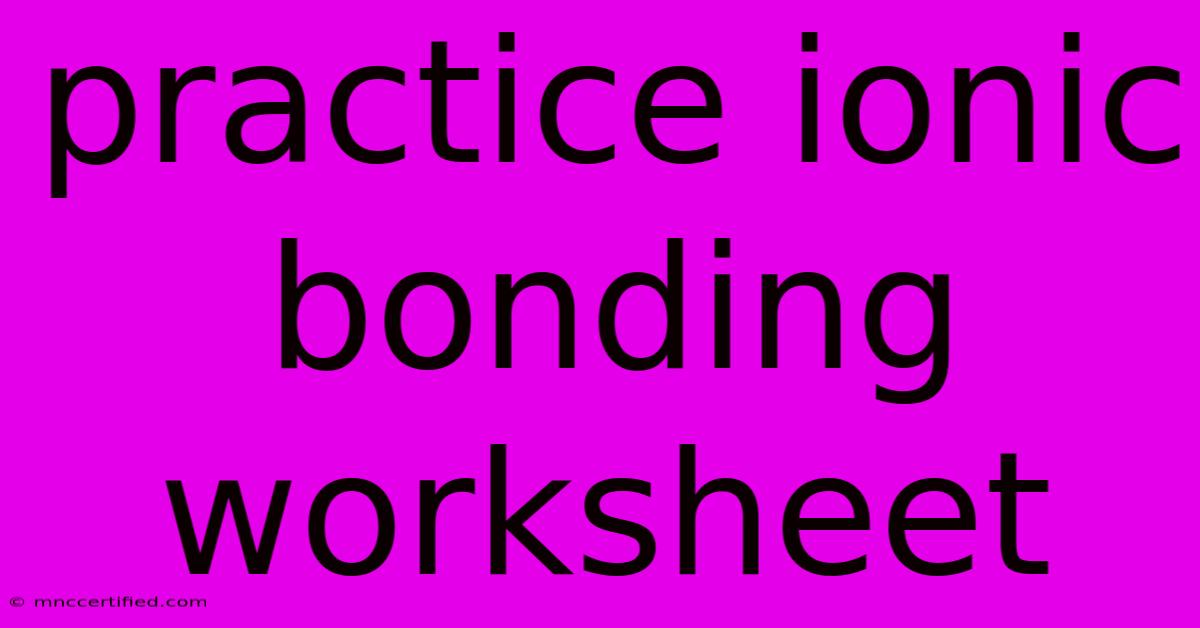Practice Ionic Bonding Worksheet

Table of Contents
Mastering Ionic Bonding: A Comprehensive Worksheet Guide
Ionic bonding, a fundamental concept in chemistry, often presents challenges for students. This article provides a detailed guide to tackling ionic bonding worksheets, covering key concepts, practice problems, and helpful tips to master this important topic. We'll focus on improving your understanding and equipping you with the skills to confidently solve any ionic bonding problem.
Understanding the Basics of Ionic Bonding
Before diving into worksheets, let's solidify our understanding of ionic bonding. Ionic bonds form through the electrostatic attraction between oppositely charged ions. This happens when one atom (typically a metal) donates one or more electrons to another atom (usually a non-metal), forming a cation (positively charged ion) and an anion (negatively charged ion).
Key Concepts to Remember:
- Electronegativity: The ability of an atom to attract electrons in a chemical bond. A large difference in electronegativity between two atoms is crucial for ionic bond formation.
- Valence Electrons: Electrons in the outermost shell of an atom. These are the electrons involved in bonding.
- Octet Rule: Atoms tend to gain, lose, or share electrons to achieve a stable electron configuration with eight valence electrons (except for hydrogen and helium, which aim for two).
- Ionic Compounds: Compounds formed through ionic bonding, characterized by a strong electrostatic attraction between ions. They are typically crystalline solids at room temperature.
Types of Questions in Ionic Bonding Worksheets
Ionic bonding worksheets typically include a variety of question types, testing different aspects of your understanding. These include:
- Predicting Ionic Compound Formation: Identifying which elements will form ionic bonds and predicting the formula of the resulting compound (e.g., predicting the formula for the compound formed between sodium and chlorine).
- Drawing Lewis Dot Structures: Representing the valence electrons of atoms and showing electron transfer during ionic bond formation.
- Naming Ionic Compounds: Applying the rules of nomenclature to name ionic compounds correctly (e.g., NaCl is sodium chloride).
- Writing Formulas from Names: Converting the names of ionic compounds into their chemical formulas.
- Determining Charges of Ions: Identifying the charge of an ion based on its position in the periodic table and its tendency to gain or lose electrons.
- Explaining Properties of Ionic Compounds: Relating the properties of ionic compounds (e.g., high melting point, conductivity in solution) to their ionic nature.
Practice Problems and Solutions
Let's work through some example problems commonly found in ionic bonding worksheets:
Problem 1: Predict the formula of the ionic compound formed between magnesium (Mg) and oxygen (O).
Solution: Magnesium is in group 2 and loses 2 electrons to form Mg²⁺. Oxygen is in group 16 and gains 2 electrons to form O²⁻. To balance the charges, we need one magnesium ion for every oxygen ion, resulting in the formula MgO.
Problem 2: Name the ionic compound with the formula K₂S.
Solution: K is potassium, and S is sulfur. The name is potassium sulfide.
Problem 3: Draw the Lewis dot structure for the formation of NaCl.
Solution: Sodium (Na) has one valence electron, and chlorine (Cl) has seven. Sodium donates its electron to chlorine, forming Na⁺ and Cl⁻. The Lewis structure would show Na with no dots and Cl with eight dots (a complete octet).
Tips for Success with Ionic Bonding Worksheets
- Master the Periodic Table: Understanding the periodic table is essential for predicting the charges of ions.
- Practice Regularly: Consistent practice is key to mastering ionic bonding concepts.
- Use Visual Aids: Lewis dot structures and diagrams can help visualize the electron transfer process.
- Seek Help When Needed: Don't hesitate to ask your teacher or tutor for clarification if you encounter difficulties.
- Utilize Online Resources: Numerous websites and videos offer additional explanations and practice problems.
Off-Page SEO Considerations
To improve the overall search ranking of this article, consider the following off-page SEO strategies:
- Building Backlinks: Obtain high-quality backlinks from reputable educational websites, chemistry blogs, and online learning platforms.
- Social Media Promotion: Share the article on relevant social media channels to increase visibility and reach a wider audience.
- Community Engagement: Participate in online chemistry forums and communities to answer questions and share your expertise.
By understanding the fundamental concepts, practicing regularly, and utilizing effective study strategies, you can confidently tackle any ionic bonding worksheet and build a strong foundation in chemistry. Remember, consistent effort and a clear understanding of the principles are the keys to success.

Thank you for visiting our website wich cover about Practice Ionic Bonding Worksheet. We hope the information provided has been useful to you. Feel free to contact us if you have any questions or need further assistance. See you next time and dont miss to bookmark.
Featured Posts
-
Philons Strong Play Boosts Draft Stock
Nov 20, 2024
-
Tax Savings When Trading In A Car
Nov 20, 2024
-
Argentina Beats Peru 1 0 Martinez Equals Maradona Record
Nov 20, 2024
-
Building The Bonds Of Attachment
Nov 20, 2024
-
Tesco Recall Salmonella Contamination Risk
Nov 20, 2024